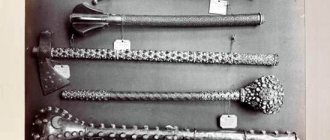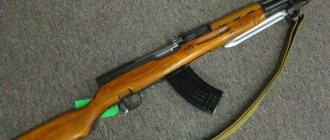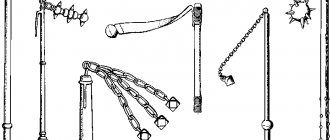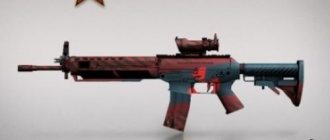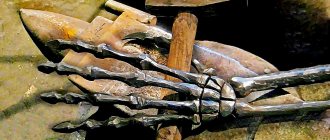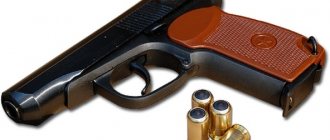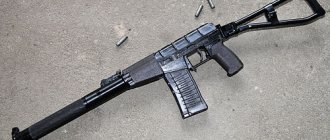This term has other meanings, see Scythe.
Braids “Forge braids.” Etching by A. Grotger, 1863 (scythes mounted on a shaft - the traditional weapon of Polish peasant rebels. Polish uprising of 1863)
Battle scythe
- this is an infantry polearm, which was a shaft or pole with a utility scythe, a shredder knife, or a specially made double-edged blade, often arched, mounted on it. This weapon was used by Polish rebels (see Cosinier), and was also found in the weapons of the Chinese.
According to the famous Austrian weapons expert of the second half of the 19th century, Vedalen Beykham, a combat scythe can be considered an Italian guisarme of the 15th-16th centuries (French guisarme) - a sickle-shaped pole weapon that had an awl-shaped process on the butt directed upward.
Polish cosigners
However, perhaps the most widespread use of the scythe (weapon) was in Poland.
This was especially clearly demonstrated during the Polish rebellion caused by the second partition of the Polish-Lithuanian Commonwealth, which occurred in 1794. Then the Polish, Belarusian and Lithuanian peasants fighting against the regular units of the Russian army formed numerous detachments, at their disposal only combat scythes and related types of bladed weapons, which were knives mounted on a shaft and all kinds of handicraft blades. The fighters of such units were called cosigners (from the words “braid”, “mow”, etc.). According to historians, the cosigners played a decisive role in the Battle of Racławice in 1794, where the rebels of Tadeusz Kościuszko clashed with government troops. Their units, united in the so-called Krakow Militia, repelled enemy attacks, lined up in three rows, and, armed with combat scythes, chopped and stabbed as if they were holding sabers and spears in their hands, and not agricultural tools converted out of necessity.
In the first row stood warriors armed with firearms, and in the second and third - with scythes. When the shooters fired a volley, they immediately retreated behind the backs of the cosigners covering them while they reloaded their weapons, which at that time required a certain time.
A similar pattern was repeated during the Polish uprising of 1830, when many of the regular infantry battalions were armed with scythes. According to the testimony of participants in those events, enemy infantrymen, even with a bayonet fastened to a gun, could not in hand-to-hand combat resist the cosigner, who inflicted chopping and piercing blows with his long and heavy scythe.
History[edit | edit code]
The history of the appearance of the combat scythe dates back to the XIV-XVI centuries. Initially, it was an ordinary agricultural implement, which the peasants, having slightly altered (bending the angle of the joint), began to use as a military weapon. For the first time, according to sources, a semblance of a combat scythe (German: schweizerisch kriegsgertel) (with a slotted cross in the warhead) was used in the 14th-16th centuries. Swiss peasant infantry of the cantons of Uri, Schwyz and Unterwalden, fighting against the Austrian knightly cavalry. Later, fighting scythes (German: Streitsense, Sturmsense, Kriegssense) were repeatedly used by the rebel Hussites (15th century) and German peasants during the so-called “Great Peasants' War” of 1524-1525. The popularity of combat scythes among peasant infantry was explained by the fact that it was the most convenient, versatile and maneuverable weapon for fighting knightly cavalry. The braids that have come down to us and are stored in Western European museums date mainly from the 16th century, but there are exceptions. For example, the battle scythe of the Prussian Landsturm of 1813. (German: Kriegssense fur den Landsturm). In Germany, combat scythes, as weapons corresponding to the capabilities of the peasants, were used for a long time in the Tyrol, during the uprisings of 1703, 1805 and 1809.
Along with combat scythes, weapons very similar to them were also used in the late Middle Ages, also derived from agricultural tools - the glaive and the kuza.
S. I. Vasilkovsky “Pospolity Cossack”, painting, 1900.
According to the general opinion of almost all Polish historians and weapons experts (V. Kwaschnevich and others), the combat scythe (Ukrainian: Boyova scythe) was an “invention” of the Zaporozhye infantry of the 17th century, which for the most part consisted of yesterday’s peasants [ unauthorized source?
]. Therefore, the battle scythe for a long time became one of the main types of weapons of the Zaporozhye Cossacks (see Zaporozhye Sich) during the national liberation war of the Ukrainian people (XVII century), and later - in the 18th century. - and the weapons of the peasant Haidamaks rebels. It is known for sure from Polish sources that the Ukrainian Cossack-peasant army used combat scythes in the famous battle of Berestechko in 1651. Polish nobles recalled that the Cossacks then effectively used the battle scythe for defensive purposes. In Russia, the combat scythe was also known in the 17th-18th centuries; it was used by peasants during the uprisings led by Stenka Razin and Emelyan Pugachev. In addition, both the Ukrainian and Russian peasantry used combat scythes during the partisan war against Napoleonic soldiers in 1812 (see Patriotic War of 1812).
As for Poland, combat scythes (Polish: kosa bojowa) were used by serfs during the Polish-Lithuanian Commonwealth during the “Swedish flood” of 1655-1660, as well as during the uprising of Tadeusz Kosciuszko (1794)
According to Wlodzhimierz Kwaschniewicz, in the battle of Rosławice, in which the battle scythe played an important role, two thousand “cosigners” took part, forming the so-called. Krakow police; She lined up in three ranks, of which the first was armed with firearms, the rest with pikes and scythes, with which in battle they cut like a saber and stabbed like a spear. It was used during the November Uprising (November 29, 1830 - October 21, 1831), when every third old battalion of regular infantry, as well as the second and third new rebel regiments, were armed with battle scythes. Józef Koszczuszko-Ozegalski recalled that “in 1863, not a single infantryman with a bayonet, having an unloaded carbine, could go hand-to-hand with a cosigner, who could chop and stab furiously with his heavy and long scythe.” A fragment from the “Analysis of the Critical Campaign of 1831” testifies to how enormous the contribution of the cosigners was to the cause of the November Uprising. General H. Dembinski, which states, among other things, that the Krakow Voivodeship alone fielded almost 60 thousand cosigners within a week. General Yu. Khlopitsky, who underestimated the role of the scythe in the uprising, wrote: “I was not a militia member and, not being in any close relationship with the peasant, did not know that his innate courage could make him terrible when he was armed with a scythe.”
Before the January Uprising of 1863-64, according to Kwaschniewicz, General L. Mieroslawski re-developed the tactics of the cosigners. Soon a witness to the uprising, an observer of the Swiss General Staff, Lieutenant Colonel von Erlach, wrote in his work “Partisan War in Poland in 1863”: “it was the single most terrible weapon, and such that a detachment of cosigners already during the march, from time to time making a muffled sound braids accidentally brushing against each other makes a terrible impression. The sight of them (cosigners) from a certain distance awakens more thunderstorms than arrows or cavalry.” Actually, commanding the cosigners, leading them into battle, the Russian revolutionary Andrzej (Andrey) Potebnya died on March 05, 1863 near Skala. The painter of the January Uprising, Arthur Grotger, dedicated his beautiful painting “Forging Scythes” to this weapon, as well as to its creators and those who fought with them. According to Kvaschnevich, in the 20th century. the combat scythe was used for the last time, playing its role in the peasant uprising of Ślą (Silesian) of 1921 in Szopieńice, as well as in September 1939 in Gdynia, where scythes were used by the so-called. “Red cosigners of Gdynia.”
Guns for infantry and cavalry
Since 1715, the overall dimensions of the fuses have also become uniform, although they depended on which units the weapons were intended for. The longest were infantry fuses: barrel - 1016 mm, total length - 1422 mm. Moreover, this was the length without taking into account the bayonet, which added about forty centimeters to the fusee. By this time, the Russian army had already abandoned baguettes - blades that were inserted directly into the barrel, as on the first examples of Peter the Great's fuses. Now these were bayonets, flat or triangular, mounted on the front of the barrel using a special tube and did not interfere with firing. Dragoon fusées, intended to arm cavalry capable of fighting both on horseback and on foot, did not have bayonets, but received a shoulder strap for attaching to a sling during a race. In addition, they were shorter and lighter than infantry ones: the barrel length was less than a meter, the weight was within 4.5 kg, but the caliber remained the same - 19.8 mm.
The loading system for both infantry and cavalry fuzes of all types was the same. To prepare for a shot, the soldier had to take a paper cartridge with gunpowder and a bullet in his bag, bite the corner and pour some gunpowder onto the charging shelf, which was then closed with a flint lid. The rest of the gunpowder, along with the paper, was sent into the barrel, the bullet was also dropped there, and the whole thing was compacted with a ramrod. After this, the shooter pressed the butt to his shoulder and pulled the trigger, the trigger dropped, the flint moved the flint, opening the ignition shelf and igniting the gunpowder on it, after which the fire penetrated the barrel through the ignition channel - and after 2-3 seconds a shot was fired. The process was slow: an experienced soldier could fire from three to six shots per minute, but the average rate of fire did not exceed one shot per minute. Each infantryman was entitled to 50 bullet charges and another 20 charges of buckshot, the weight of which was equal to the weight of the bullet, and the dragoons were entitled to 40 charges.
Fuseler of the Dragoon Regiment, from 1700 to 1720. Drawing from the monograph by Alexander Viskovatov “Historical description of clothing and weapons of the Russian troops, with drawings, compiled by the highest order,” 1841-1862.
Comments
Comment by mbulmer
While the tooltip makes no mention of this, you will receive the 20 Rage/150 Mana bonus if you achieve a killing blow on an opponent in PvP as well.
Comment by pigmonkey
This drops off Ragnaros with a fairly low drop rate. If it does drop, it will drop independent of Rag's normal loot table (meaning you get an extra epic).
Comment by Monstrado
This is a great weapon for a warrior in battlegrounds. This weapon really shines when you have a dedicated healer so you can plow through people without stopping (generating rage each kill).
Comment by kniteshift
Drops off Ragnaros, and is a pretty great ax overall in pve, and most beneficial in pvp for a warrior, due to +5% ax talent they can spec in.
Comment from 9029
I wouldn't have any other class than a warrior take this, unless the warriors in the raid didn't want it. Why? Simply put, because 150 mana is almost non-existant when compared to 20 rage.
Comment from 8976
I agree here. 20 rage is a lot more than 150 mana. It's best for warriors, if no warriors want it it should go to a paladin then an enchantment shaman.
Comment by Taiyoumaru
As a paladin I'd like to have it for my greedy little self but if a fury/arms warrior would want it, I'd pass. There's a lot of other great 2handers for paladins out there anyway. It looks very good tho. As a paladin I wouldn't just look for raw damage myself as getting items with great dps but otherwise statless isn't as efficient.
Comment from 9029
Ryyz: The damage alone on the weapon makes it ideal for every class that can use it, that and the bonus attack power that it gives. However, I stick with what I have said. 20 rage for a warrior, according to what I've seen, is equal to basically 2 thirds of a mortal strike, to a revenge, rend, overpower, heroic strike, and so on. I'm not doubting what you're saying though regarding paladins. And regarding an enhancement shaman, personally I'd prefer something with a proc on it (like Ragnaros's hand, or just about anything with a Chance on hit) and some stats on it. The possibility of having 3 of those procs, okay, 2 of those procs in a row is fun to think of. But hey: high enough damage on a weapon works as well to consider it windfury material.
Comment by Allakhazam
obviously made for BG rather then TM GANKING
Comment by Allakhazam
“bubble” is a class skill that is in the pally class itself. If he's in a fight, expect that a person would use all his given abilities. It's only 12 year old retards who come on here and claim how unfair it is for a paladin to heal themselves or when they use their “bubble”.How about you try fighting a pally without using any of your insta attacks and the pally doesn' t use his bubble. The pally would rape you.given that if both classes use all the abilities on them, the pally is more than capable of winning or losing to an equally equipped warrior.
Comment by Allakhazam
the best endgame ax ive seen besides PvP ax
Comment by Allakhazam
I have no experience with abilities that take place 'after killing a target that yields experience'. Only things that relate to this that I can think of are a rogue and warlock talent (can't fully remember their names). ANYWAYS, so does this work after killing in PvP? They don't 'yield' experience but…
Comment by Allakhazam
Do Hunters actually feel insecure at the thought prim melee classes have better melee weapons than they? Hunters get the epic ranged, for melee they should only ever get thrown the scraps that no one else wants! — Even a palay deserves better melee than hunter...n thats saying something!Edited, Wed Sep 21 13:48:30 2005
Scythe - a weapon of the Cossacks
At the same time, it should be noted that the area of use of combat scythes in the Middle Ages was quite wide and was not limited to Western Europe. This type of weapon was no less actively used on Russian territory. Even professional warriors, such as the Zaporozhye Cossacks, did not disdain the use of combat scythes. However, to be fair, it is worth noting that experienced Cossacks preferred classic weapons, while newcomers, out of village habit, used combat scythes as weapons at first. The heyday of the use of these weapons in our country occurred in the 17th-18th centuries, the time of the most large-scale peasant riots and unrest. Since regular troops manned by cavalry were sent to pacify the troublemakers, the use of combat scythes against them was not only convenient, but also quite logical. Sometimes entire detachments of the people's armies of Stepan Razin and Emelyan Pugachev were armed exclusively with this simple but incredibly effective weapon. It got to the point that when former peasants, who had acquired professional weapons in battle, tried to get rid of their battle scythes, the atamans forbade them to do so. There was only one reason: the incredible effectiveness of this weapon against cavalry.
Capabilities
Originally, the Grim Reaper was a purely technological villain with no innate superhuman abilities. The Reaper and the technique he used as his signature weapon were developed by the Tinkerer. The scythe he carries on his right arm has the ability to cause the blade to spin at high speeds, making the weapon a sort of circular saw, a shield to protect against external impacts, and a makeshift helicopter. She could create electromagnetic explosions and release anesthetic gas pellets, and give an electric shock when touched. The scythe was also equipped with a brain frequency generator that was able to put victims into a deep coma, as well as restore them back from this state.
The Grim Reaper later gained some magic-related abilities: he could bring the souls and bodies of the dead back to life, through the training of voodoo magic by the Black Claw or the abilities granted to him by Lloigoroth. The Grim Reaper also demonstrated other magical abilities, but was not limited to them: teleporting himself and others, summoning demons, creating illusions and seeing what was happening (clairvoyance).
In the media
Cartoon series
The Grim Reaper appears in The Avengers. Always Together” voiced by Allan Royal. He appears in the episode "The Sorceress's Apprentice", this version wore armor covering his entire body and a helmet with a skull design.
The Grim Reaper appears in Avengers: Earth's Mightiest Heroes, voiced by Lance Henriksen. He is featured in the episodes "Natural Iron Man", "Escape: Part 1", "Living Legend", "Everything Is Wonderful", "Operation Black Panther" and "The Sting of the Black Widow". In addition to being Wonder Man's brother, the Grim Reaper is a member of HYDRA.
The Grim Reaper appears in Iron Man: Armored Adventures. He is featured in the episode "Search for the Mandarin", where he appears as the Guardian of one of the Makulan rings.
The Grim Reaper appears in Avengers Assemble, voiced by Roger Craig Smith. He appears in the episodes "Undercover", where he was captured by the Avengers along with the villain Crossbones. In the episode "The Rising of Thanos", the Grim Reaper attacks the military in order to gain control of the missiles and use them to destroy Stark Tower and half of Manhattan.
Animated films
The Grim Reaper appears in Avengers X-Files: Black Widow and the Punisher in an uncredited role. He appears as a buyer for Organizational Leviathan, who plans to auction off S.H.I.E.L.D.'s stolen technology.
Games
The Grim Reaper appears as a boss at the end of Round 2 of Captain America and the Avengers for Sega Genesis and SNES. The Grim Reaper appears as a miniboss in Marvel: Ultimate Alliance 2, voiced by Rick D. Wasserman. The Grim Reaper is shown as boss in the Facebook game "Marvel: Avengers Alliance". The Grim Reaper is featured as a boss in "MMORPG Marvel Heroes", voiced by Robin Atkin Downes.
End of the Middle Ages
In the era of the late Middle Ages, that is, the historical period discussed above, a weapon in the form of a scythe, which was its more advanced version - the glaive, or glaive, was also widespread. It was intended mainly for close combat and was a one and a half meter shaft with a flat, sharpened tip mounted on it, about 60 cm long and 7-10 cm wide.
To protect the shaft from damage, it was covered with rivets or even wrapped with steel tape. The blade, sharpened, as a rule, only on one side, was equipped with a steel spike extending at an angle to the side. With its help, it was possible to reflect blows delivered from above, as well as respond to them yourself, piercing the enemy’s armor with a sweeping edge. In addition, it was very convenient for them to pull the rider off the horse and deal him a fatal blow on the ground.
Thus, the glaive, which made it possible to deliver both slashing and piercing blows in battle, was a rather formidable weapon. It was widespread throughout Europe, but was especially popular in France and Italy, where it was an indispensable attribute of the honor guards of all senior government officials. There it was eventually transformed into a special type of halberd called a guisarma. As a rule, it was equipped with two tips - straight and curved - and allowed the fighter to deliver piercing blows and pull the enemy off the horse.
Knight's spear
I take my hat off to whoever can withstand the blow of a knight's spear.
Yes, all of the weapons listed can kill if used correctly, but of all the weapons mentioned, they either crush, chop, cut, or pierce. In many cases, the victim survives or dies soon after, within a few days. The name of the word "spear" comes from the word lancea - "javelin" of the Roman auxiliary or throwing impact weapon. Although according to the Oxford English Dictionary (OED), the word "spear" may be of Iberian origin. Also the entomology word λόγχη (lónkhē or "spear"), has Greek roots for the terms "javelin" or "spear".
A spear in its original sense was a light throwing weapon, or dart. The English verb for action: "throw, hurl, hurl" comes from the term (old French) and also from the rarer or poetic lance ‒ "spear".
The 17th century term means that the weapon is specifically related to the spear, not as a thrown weapon, but as used as a thrust by heavy cavalry, and especially in jousting tournaments. The thrusting spear used by infantry is usually called a "pike".
During the classical and medieval periods of warfare, the javelin became the leading weapon in cavalry units, and was unsuitable for throwing or repeated thrusts, unlike the similar pike javelin weapon commonly used by infantry.
Spears were often equipped with a plate, a small round plate, to prevent the hand from sliding up the base of the spear during a strike. Although the spear was known as a military and sporting weapon used by European knights, it also spread widely to Asia, the Middle East and North Africa, wherever suitable mounts were available.
As a secondary weapon, lancers of the medieval period also carried swords or maces for hand-to-hand combat, as spears were often disposable weapons. Assuming that the spear remained intact after the initial impact, it (unlike the pike) was too long, 9 to 14 feet (2,740 mm to 4,267 mm), heavy and unwieldy to be effective against the enemy in close combat.
Scythe in the arsenal of the Zaporozhye Cossacks
It is also interesting to note that the battle scythe is a weapon, the honor of whose invention is disputed by many nations. For example, a number of researchers believe that it first appeared in the arsenal of the Zaporozhye Cossacks, most of whom were former peasants. It is difficult to say how substantiated this statement is, but the fact is undeniable that during the Ukrainian national liberation war of the 17th-18th centuries, this particular weapon was one of the main ones.
The death scythe played a decisive role in the Battle of Berestetsky, which took place in 1651 between the army of the Polish king John Casimir and the Cossacks of Hetman Bohdan Khmelnytsky. There are memories of the gentry telling that it was with the help of battle scythes that the Cossacks were able to carry out defense and subsequent counterattacks extremely effectively.
Recently, a large number of exhibits related to the role of this type of weapon in the battles for the independence of Ukraine have appeared in the collections of the Zaporozhye Historical Museum. They constitute a full-scale and complete collection, reflecting different periods of production and improvement of combat scythes by gunsmiths of this region.
Birth of a legend
It's amazing how quickly once popular things fade into obscurity. Almost no one remembers the combat scythe today, although just a couple of centuries ago it was considered one of the main types of bladed weapons. Moreover, the last mass use of combat scythes occurred in the first year of World War II. In Poland in 1939, the Poles successfully used this unusual weapon against the cavalry and soldiers of the Third Reich, earning the title of “red cosigners of Gdynia.” However, the date of the invention and first use of this weapon is lost in the darkness of centuries. Historians claim that even the ancient Greek historian Xenophon in his writings mentioned the weapons of Persian warriors, which were described as reminiscent of combat scythes. Nevertheless, in the chronicles of the Middle Ages, this weapon appears in the middle of the 14th century and instantly becomes extremely popular. As a rule, this fact is explained by military historians solely by the manufacture of weapons and their convenient use in battle. When the need for a combat scythe arose, European peasants unbent the tip of an ordinary scythe along the handle, strengthening the attachment to the handle with an additional iron fitting. It turned out to be something between spears, which only soldiers had at that time, and a sword on a long wooden handle. This weapon could be used with equal success in the people's militia, as well as during numerous religious and peasant uprisings. With the help of a battle scythe it was possible to resist both foot soldiers and horsemen with equal success.
The battle scythe belongs to the strong and brave
The pictures of weapons presented in the article (scythes and their modifications) allow us to imagine the variety of types that gunsmiths of different times and countries created, using ordinary agricultural tools as a basis. The closest relatives of the scythe were not only the guizarmes, which were described above, but also siege knives and mowers - combat pitchforks.
The use of this type of weapon in battle did not require any special training - the technique of using it was quite simple. It was only necessary to have endurance, physical strength and, of course, a fair amount of courage, which is necessary for a fighter regardless of what weapon he has in his hands.
Supermen of the Middle Ages
Warlords around the world soon discovered that the armored cavalry, armed with a long spear and attacking with a ramming blow, became the most effective branch of the army. So effective that it paid for the considerable costs of armament and training of the rider. Armored riders could defeat infantry that greatly outnumbered them.
If at the beginning of the Dark Ages of the Middle Ages infantry still continued to play a significant role, including the free subjects of the king, then as armor and weapons improved, heavy cavalry became an increasingly important part of the armies of that time. And not only in Europe
Battle of Hastings
The appearance of the heavy knight's spear completed the creation of a complex of weapons for armored cavalry. Unlike the copies of Antiquity and the early Middle Ages, the new weapon was intended only for ramming, reached a length of four meters, and had a massive tip that could pierce even heavy knightly armor. After this, the gunsmiths could only improve the armor of the rider and his horse. Popular for centuries, chainmail gave way to forged plate armor, which then evolved into full plate armor.
Japanese modification of the combat scythe
The Japanese combat braid is also known to historians as a special variety. This weapon is somewhat different from the one discussed above. Also, being a modification of an agricultural implement, it nevertheless underwent quite significant changes. First of all, even with a quick acquaintance, what catches the eye is the shortened shaft, to which the blade is attached almost at a right angle. This type of weapon is often called a combat sickle.
Despite the fact that such a design reduces the angular velocity of the weapon upon impact and thereby reduces its lethality, it provides the fighter with greater maneuverability and makes him extremely dangerous in close combat. In some cases, a weight was attached to the shaft on a long chain, and by untwisting it, it was possible to inflict a strong, devastating blow on the enemy.
Background[edit]
The scythe in its modern form appeared quite late, on many continents only with the advent of European civilization. Derived from the sickle - the very first sickles were essentially large, slightly curved knives, first made of stone and later bronze. From their combat varieties came swords - the ancient Egyptian khopesh and the ancient Greek kopes. The one-handed version of the sickle began to be made in the form of a thin crescent - hence the classic sickle. In another case, the blade was placed on a long handle perpendicular to it, and this is how it turned out, for example, the Japanese kama - often found in the form of ninja weapons in anime and manga. In Europe of the first millennium, its variety was widespread - pink salmon, which is sometimes found today. And only in the late Middle Ages did the Lithuanian braid appear - actually an ordinary and classic braid. So the scythe and sickle may well be combined into one theme.
Period of peasant wars
A century later, the entire central part of Europe was engulfed in bloodshed, which broke out for a number of economic and religious reasons and was called the Great Peasant War. Once again, the scythe (weapon) often decided the outcome of battles, since the armies of the warring sides were staffed mainly by peasants who could not afford more expensive types of weapons.
Most of the combat scythes exhibited today in various museums around the world date back to the 16th century, but there are also later examples. One of them is a scythe (weapon), which once belonged to a Prussian militia and, according to the mark on it, was issued in 1813. It can be seen in the Dresden State Museum.
Biography
Eric Williams, brother of Simon Williams (also known as Wonder Man), was born in Paterson, New Jersey. Eric was the “black sheep” in his family. His mother would tell him he was 'born bad' while all her love was focused on Simon. Eric's father was cruel and uncaring. He even preferred to lazily watch TV while Eric tormented the family cat. At the same time, their mother Martha was loving and attentive to Simon, which made Eric sad and jealous.
One day, Eric was playing with chemicals in the garage, which caused a fire that burned their house to the ground. Simon felt guilty for not stopping Eric and then he decided to be responsible for Eric. As they got older, Simon became a studious person, while Eric was an athlete. Eric also became more rebellious, and tried to force Simon to join him in his petty thefts. Eric eventually became a gambler and joined the Maggia crime syndicate and moved to Las Vegas. While Simon took over the family business, Williams Innovations.
The Grim Reaper reappeared during the aftermath of the Secret War, which was organized by Nick Fury against Latveria. He was among the supervillains who were weaponized by the Latverian dictator, Lucian Von Bardos, and sent to attack the heroes who were involved in Fury's Secret War.
The Grim Reaper was apparently one of the many villains who escaped from Raft's prison during New Avengers #1-3. After being at large for several months, the Grim Reaper was eventually tracked down by Captain America and Cable during the "Civil War" storyline. Captain America and Cable defeated the Reaper with the help of their other allies. He was found tied up with the Vulture. He was once again sent to SHIELD custody.
The Grim Reaper is then seen at the end of Heroes for Hire #6, approaching Man-Ape and the Super Saboteur.
During the "Dark Reign" storyline, the Grim Reaper later formed the new Lethal Legion as part of a plan against Norman Osborn after Osborn's rise to power. The team is eventually defeated by the Dark Avengers and HAMMER agents and imprisoned in Raft. It is also shown that his brother Simon is a member of the Legion, also imprisoned in Raft. It was eventually revealed that the Reaper died as a result of a stabbing.
During the "Chaos War" storyline, the Grim Reaper returns from the dead and becomes the servant of Amatsu-Mikaboshi. He and Nekra fight the "Dead Avengers" (consisting of Captain Marvel I, Ditkry, Doctor Druid, Swordsman I, Vision I, and Yellowjacket II). He manages to kill most of them except for Swordsman and Yellowjacket. The Grim Reaper and Nekra are killed when Vision self-destructs.
Device and application
The scythe blade was placed in the split upper part of the shaft and covered with iron hoops or riveted into the shaft, while the shaft in the upper part was wrapped with wire to protect it from being cut. A combat scythe with a hook could easily be hooked and pulled off a knight's horse; it was convenient to cut the tendons of horses and thereby neutralize the cavalryman and deliver a strong slashing blow.
Around 1550, a two-volume treatise on martial arts, De arte athletica, was published in Augsburg (Germany), authored by Paul Hector Mair. This beautifully illustrated treatise, written in Latin, talks in detail about teaching various techniques of hand-to-hand combat and combat with all kinds of edged weapons (even peasant implements: sickles, hammers, scythes, etc.!), including various “dirty” techniques and tricks. The combat techniques of “infantry-cavalryman” and “cavalryman-cavalryman” are given. The description of each technique is accompanied by a beautiful color illustration, accurately depicting the clothing and armor of infantry and knights of that period (the illustrations of the second volume are especially beautiful).
P. Aigner in the section of his work “Tactics of the Corps of Pikemen and Cosigners” wrote: “according to the rules of good tactics, the weapons in three rows should be mixed: the first row is firearms, the 2nd pikes, the third – scythes. There are other good ways in which the 1st row can have weapons with bayonets, the 2nd with scythes, and the 3rd with pikes; or: 1st row - 1st person had a pike pointed towards the attack, and the 2nd simply walks, holding a cutting scythe vertically, 2nd row - pikes, and 3rd - auxiliary - scythes.” In addition to Aigner’s work, a number of other monographs were published on combat tactics with a scythe. Another book by Aigner, “A Brief Science of Scythes and Lances,” in addition to describing the methods of using those rebel weapons, recommended deep, well-thought-out tactics of war with these weapons: running with scythes in formation in cooperation with pikemen and riflemen armed with carbines, the same in interaction with artillery, which, during the attack of the “cosigners,” finished off the enemy with artillery fire. Aigner wrote: “Scythes were terrible weapons in the hands of their owners who fought for freedom and independence. The scythe, with its brilliance, frightens the horse, depriving the cavalry of the advantage and makes this weapon more terrible than the broadsword and inflicts fatal blows on them.”
Dart (or pike)
Darts and pikes may have been simple in design, but they have proven to be effective melee weapons for thousands of years.
The length of the dart ranges from six feet (1800 mm) while the length of the pike was slightly longer - up to 9 feet (up to 2430 mm). The purpose of using a javelin in battle was to keep the enemy at a distance by piercing him with it, or if a given infantryman had additional javelins or a free hand with a shield, he could throw it at the enemy.
Throwing javelins were used not only against infantry, but also against cavalry units - and very effectively.
The purpose of using a pike for cavalry and infantry is to pierce, not tickle. A good pike in the hands of a trained person could pierce flesh and destroy bone, killing with one blow.
Peasant braids that became weapons
The first use of this agricultural tool for military purposes began in the 14th century. Usually peasants, who for one reason or another decided to forcefully change the existing way of life or were forced to repel the attack of enemies, remade their braids. By changing the angle of attachment of their cutting parts to the shaft or simply strengthening them on a common axis with it, they achieved an effect in which yesterday’s completely harmless scythe became a deadly weapon.
Cold steel created in this way had a number of advantages. It was universal, maneuverable, effective, but most importantly - cheap and accessible. Sometimes, instead of a regular scythe blade, a sharpened shredder knife or a specially forged double-edged and slightly curved blade was attached to the shaft.
Trebuchet – “scales with a yoke”
The Trebuchet (or "yoke oar") is a siege engine first developed and used in Ancient Rome and survived in Western armies that took their lineage from Ancient Rome.
The Trebuchet was used in all of the early European wars, as well as during the First Crusade. Some historians claim that the Trebuchet was developed in China, and from there, was adopted by Islamic armies, however, at present, the reliability of this theory is under significant doubt.
The Trebuchet was a type of catapult that required many men to operate it due to its enormous size and weight.
The amount of energy required to send the projectiles to the appropriate range required each vehicle to have a team of more than 100 people to pull a dozen ropes that generated enough force to send a 130 lb (59 kg) projectile to a range of up to 500 feet ( up to 152 meters).
The purpose of using Trebuchet was to weaken and destroy fortress walls. This machine could not only fire stone projectiles, but also incendiary ones. While stone was intended to crush and destroy walls, incendiary projectiles were thrown over castle walls or city walls to set buildings on fire.
Of course, if you wanted to inflict special suffering on the defenders, you could start a plague; this was simply done by loading the bodies of plague victims and sending them over the walls, as the Mongols did at Caffa in 1347.
Last battles of chivalry
At this time, the era of military glory began for the Swiss, who lived in the Alps in strong communities and did not want to recognize anyone’s power over them. The detachments, composed of residents of the same locality, often relatives, were distinguished by high cohesion and morale. And since at that time the Swiss were considered such wild mountaineers, it is clear that they fought with great ferocity.
At the Battle of Morgarten (1315), the Swiss defeated the Habsburg army. But this was not yet a triumph for the infantry - after all, the Swiss attacked the enemy on the march, in the forest, where the knights could not take advantage of their advantage.
The time came in 1477. At the Battle of Nancy, dense ranks of Swiss infantry armed with pikes and halberds, with the first ranks protected by armor, defeated the Burgundians - the best army in Europe under the command of the outstanding commander Duke Charles the Bold.
E. Delacroix, Death of Charles the Bold at the Battle of Nancy on January 5, 1477"
The symbolic decline of knighthood is considered to be the Battle of Pavia (1525), where the leader of the German Landsknechts (mercenary infantrymen) Jorg von Frundsberg first defeated the Swiss infantry, which was considered invincible, fighting on the side of France, and then completed the job with the defeat of the French gendarmes - the heirs of the knights. French armored horsemen, led by King Francis, fought heroically against the German knights, but the infantry advance, supported by arquebus fire, scattered the French forces. The gendarmes were killed, and the king was captured.
Although it was in the Battle of Pavia that firearms showed their high effectiveness, the final victory over chivalry - contrary to popular belief - was not won by shooters. Neither the English longbow, nor the crossbow, nor the first arquebuses knocked out a well-armored cavalryman from the battlefield.
The only weapon against the mass of cavalry was the close-knit ranks with their pikes forward. Already in modern times, during the renaissance of heavy cavalry - with the advent of cuirassiers - infantry (armed with much faster-firing rifles) could resist them only by standing in a square with the support of energetic artillery fire.
